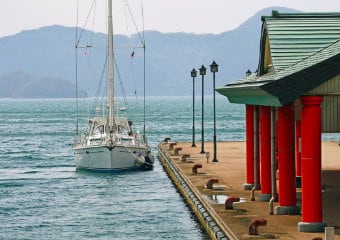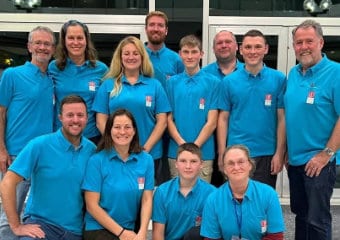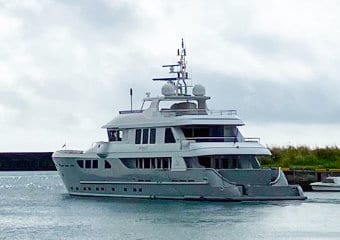
S/V Capaz Cruising Off the Northwest Coast of Honshu; Photo: M/V Starr
For many years, Japan was “terra incognita” on the world cruising map. Few cruisers came to Japan and those who did typically passed through quickly, south to north, on their way to Alaska/British Columbia. It was not a destination in its own right.
But now Japan is “hot.” Cruisers around the world are increasingly looking at Japan as a place that they want to visit and are making long-term voyage plans that include Japan….and that include long stays in Japan.
Japan’s rise as a popular cruising destination is primarily the result of the rave reviews it has received from cruisers over the past decade or so. Among the many positive aspects of cruising Japan, they cite the friendly people, the rich history and culture, the scenery, the delicious cuisine, and the safety. And the recent, dramatic depreciation of the yen has made it a very affordable place to visit.

Anchored at Omura bay, Nagasaki; Photo: S/V Muktuk
In the past, those positives were significantly offset by one big negative – mind-boggling bureaucratic requirements. Specifically, one had to apply annually for a special permit to be allowed to enter Japanese closed ports (98% of all ports), and that required preparing a detailed list of all closed ports that one might want to enter (in the six years I cruised Japan, every January I spent a week preparing a list of about 600 closed ports along my planned route that year). In addition, Customs officials were very inconsistent in their willingness to give foreign cruisers “Naikosenpaku” status to exempt them from having to follow the extremely strict paperwork and operational requirements designed to control cargo ships. Moreover, superyachts (pleasure craft over 24 meters) could not easily get a Closed Port Permit or Naikosenpaku status and their crew, depending on their nationality, were not able to get long-term visas.

S/V Atisha and S/V Bob Moored at Iki Island; Photo: S/V Atisha
In the past few years, though, much has changed. As a result:
- Cruisers can receive, with a simple one-page application, a Closed Port Permit that covers all of Japan and that is valid forever;
- Customs seems willing to grant Naikosenpaku status to all foreign cruisers when they arrive in Japan (although there is still considerable inconsistency in what local Customs offices require as part of the Naikosenpaku application process);
- Superyachts can get Closed Port Permits and Naikosenpaku status and their crew can stay in Japan for as long as their boat is in the country (up to a year).
So there are lots of positives and very few negatives for Japan as a cruising destination. And Japan is therefore featuring prominently on cruising maps.
In addition, the challenges of doing a global circumnavigation, especially the prospect of having to choose between the human risks of the Middle East or the natural risks of South Africa, are leading some cruisers to do a circum-Pacific voyage instead. And the attractions of Japan make that option even more appealing.
As a result, the number of foreign cruisers coming to Japan jumped significantly in 2023. It probably would have increased steadily over the past few years, but it was almost impossible to enter Japan during Covid, so pent-up demand resulted in a rush of boats to Japan this year. There are no accurate statistics, but anecdotal evidence is that, pre-Covid, only about 20 foreign cruisers came to Japan every year, but this year that number is probably over 50 and it is likely to be much higher in 2024.

Kerama Island, Okinawa; Photo: M/V Starr
In addition, cruisers are staying longer. In the past, the standard pattern was for a cruiser to enter Japan in Okinawa (far south) in March-April and then leave Japan from Hokkaido (far north) in early June (i.e., within the standard 90-day visa period). Now, however, the majority of foreign cruisers are staying for 180 days (making a quick visa run to Korea after 90 days), leaving their boat in Japan over the winter, and then returning the following spring to go to Alaska/Canada (or sometimes SE Asia) or to cruise Japan for another 180 days.
Just looking at my business, I had four cruising clients in 2019 but have had 16 in 2023 (including three holdovers from previous years), and I already have about a dozen semi-confirmed clients for 2024 (I say “semi-confirmed” because cruisers’ plans are always changing; two boats that planned to arrive this year are now scheduled to arrive next year and two clients initially booked for next year have postponed to 2025).
In looking at my 16 2023 clients, I am struck by the incredible diversity of boats, crew, and passage plans. As shown in the attached map and table:
- They flew 11 different flags – six North America, five Europe, three Australia/New Zealand, and two Asia;
- There were 12 sailboats (10 monohulls, 2 catamarans) and four power boats (3 monohulls, 1 catamaran);
- Boat size ranged from 35’ to 114’ (average of 59.7’);
- Crew size ranged from one to seven (average of 3.3);
- 12 entered Japan in Okinawa (including nine in Yonabaru, because that is where I typically recommend that clients arrive), with the other four entering in central Japan;
- The Seto Inland Sea and the west coast of Kyushu were the most popular cruising areas, but a 79’ Hong Kong monohull only visited the Okinawa islands and then went to Taiwan, while a Polish catamaran went very quickly to mainland Japan and then on to Canada;
- As I write this in early November, 12 of the boats are still in Japan, although an Austrian boat (delayed by a broken mast) will leave the country shortly. Two boats have just arrived in Japan within the past 10 days and will probably stay for 1-2 years. Only one boat, an American power boat, did the once-classic three-month trip of Okinawa to Hokkaido to Alaska (although another American boat also tried to go to Alaska but was turned back by weather – they will try again next year).

| # | Flag | Length (ft) | Boat Type | # of Crew | Arrival Date | Arrival Port | Location (Nov 2023) |
|---|---|---|---|---|---|---|---|
| 1 | USA | 110 | Power Catamaran | 6 > 3 | November 2019 | Naha, Okinawa | San Francisco |
| 2 | USA | 50 | Sail Monohull | 2 | May 2021 | Yonabaru, Okinawa | Otaru, Hokkaido |
| 3 | UK | 35 | Sail Monohull | 1 | May 2021 | Tannowa, Osaka | Fukuoka |
| 4 | Germany | 49 | Sail Monohull | 2 | March 2023 | Yonabaru, Okinawa | Fukuoka |
| 5 | USA | 77 | Power Monohull | 4 | March 2023 | Yonabaru, Okinawa | Seattle |
| 6 | USA | 45 | Sail Monohull | 3 | April 2023 | Miyako, Okinawa | Nagasaki |
| 7 | Austria | 48 | Sail Catamaran | 2-3 | May 2023 | Yonabaru, Okinawa | Okinawa |
| 8 | Poland | 41 | Sail Catamaran | 4 | May 2023 | Yonabaru, Okinawa | Vancouver |
| 9 | Belgium | 79 | Power Monohull | 5 > 3 | May 2023 | Yonabaru, Okinawa | Fukuoka |
| 10 | Canada | 52 | Sail Monohull | 3 | May 2023 | Yonabaru, Okinawa | Fukuoka |
| 11 | New Zealand | 37 | Sail Monohull | 2 | June 2023 | Wakayama, Wakayama | Oita |
| 12 | New Zealand | 45 | Sail Monohull | 1 | June 2023 | Wakayama, Wakayama | Fukuoka |
| 13 | Australia | 43 | Sail Monohull | 2 | June 2023 | Wakayama, Wakayama | Fukuoka |
| 14 | Hong Kong | 79 | Sail Monohull | 7 | June 2023 | Ishigaki, Okinawa | Taiwan |
| 15 | Malaysia | 114 | Power Monohull | 6 | October 2023 | Yonabaru, Okinawa | Okinawa |
| 16 | Canada | 51 | Sail Monohull | 2 | November 2023 | Yonabaru, Okinawa | Okinawa |
- Trapped by Covid in Okinawa, managed by Konpira Consulting; with delivery crew, left Japan in June 2023, arrived San Francisco in August
- Trapped by Covid in Fukuoka, managed by Konpira Consulting; in 2023, sailed Sea of Japan to Hokkaido, left for Alaska in June, turned back by weather; at Otaru, Hokkaido, until spring 2024
- Trapped by Covid in Osaka; 2022 - some sailing in Seto Inland Sea; 2023 - cruised Seto Inland Sea, west Kyushu; now in Fukuoka; to SE Asia in February 2024
- Cruised Ryukyu Islands, west Kyushu; now at Fukuoka; will cruise Kyushu and the Seto Inland Sea in fall/winter and then sell boat in Japan or cruise to Alaska
- Cruised Ryukyu Islands, west Kyushu, Seto Inland Sea, Sea of Japan; left Kushiro for Alaska in May 2023
- Boat trapped in Taiwan by Covid for three years; new owner finally able to bring her to Nagasaki home port
- To Seto Inland Sea to Yokohama; planned to go to North America but damaged mast forced change of plan; now in Okinawa, will sail to SE Asia in November 2023
- Quick passage to Choshi, Chiba, then left in early June for Canada
- Quick passage to Fukuoka; children in Japanese schools; depart spring 2024 for Alaska/Canada
- Cruised Ryukyu Islands, west Kyushu; now at Fukuoka; will go to Hokkaido to Canada in spring 2024
- Part of NZ-Japan Rally to Seto Inland Sea; boat sold to foreign resident of Japan, moored in Oita
- Part of NZ-Japan Rally, to Seto Inland Sea and Kyushu; will winter in Fukuoka; to Canada in 2024
- Part of NZ-Japan Rally, to Seto Inland Sea and Kyushu; will winter in Fukuoka; to Alaska in 2024
- Main goal: diving for owner/guests in Yaeyama Islands; at Yonabaru for a month, then to Taiwan for repairs; probably return to Japan in spring 2024 and go on to Alaska/Canada
- Diving for owner/guests in Yonaguni then through Ryukyu Islands to Kyushu and Seto Inland Sea; may stay for 6-12 months
- Planned to arrive in spring 2023, but delayed by weather to November; will moor in Seto Inland Sea for 1.5 years and explore Japan, then to Canada in 2025
Japan will almost certainly become one of the world’s great cruising destinations in the years to come. Fortunately, though, the country is unlikely to become crowded like the Mediterranean and the Caribbean. Japan is vast (northern Japan is at the same latitude as Montreal, southern Japan is at the same latitude as Key West, Florida) and the coastline is dotted with thousands of fishing ports where one can easily find a moorage spot, for free.
For the adventurous sailor who wants to interact with the locals (not other cruisers), experience a unique culture, enjoy delicious food and drink, and not worry about their safety, it’s hard to find a better place than Japan





